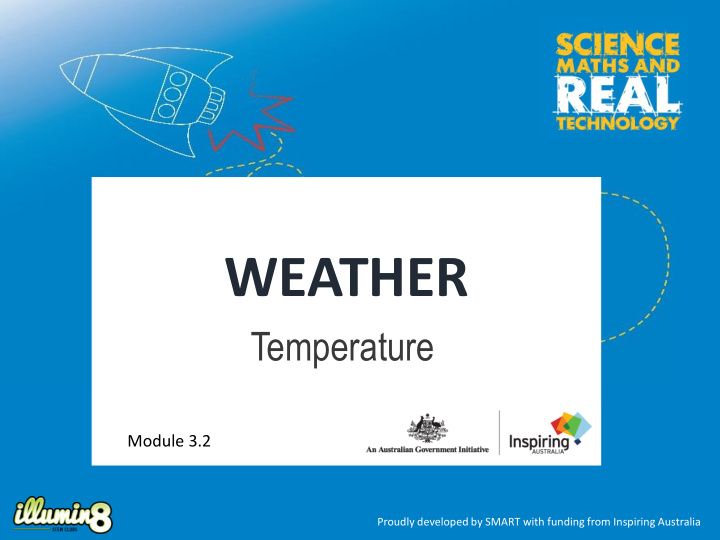



WEATHER Temperature Module 3.2 Proudly developed by SMART with funding from Inspiring Australia
How did you go with observing and forecasting?
What is Image Sources: https://extension.illinois.edu/treehouse/seasons.cfm?Slide=11 www.pixabay.com
Aim: To observe the effect of temperature on water Materials (per group): • Glass bottle • Clear straw • Cold water and hot water • Food colouring • Modelling clay • Container/tub (wider than the bottle) Procedure: 1. Form into groups and collect materials. 2. Add a few drops of food colouring to the bottle. 3. Fill the bottle up to the bottom of the neck with cold water (almost full). 4. Place the straw in the jar. Use the modelling clay to position the straw in the centre of the jar. Make the seal around the straw and jar as tight as possible, like a lid. 5. Add hot water to the container. Stand the bottle inside the hot water container. 6. Observe the results! Note: Use a heat proof glove to remove the bottle from the hot water. What happens if you place the bottle in a container of cold water? Image Source: https://www.stevespanglerscience.com/lab/experiments/water-thermometer-sick-science/
Why do we measure temperature ? Image sources: www.pixabay.com
Temperature: Chemical Reactions Image source: www.pixabay.com
Aim: To observe how temperature affects the rate of a chemical reaction. Materials (per group): • 3 glow sticks of the same colour • 2 cups • Hot and cold water • Marker Procedure: 1. Form into groups and collect materials. 2. Fill one cup with hot water, label ‘HOT’ with the marker. 3. Fill the second cup with cold water, label ‘COLD’ with the marker. 4. When you are ready to commence, snap all three glows sticks at the same time, to start their chemical reactions. 5. At the same time, place one glow stick into the hot cup and one into the cold cup. Leave one glow stick on the bench. 6. Darken the room, observe how brightly the glow sticks glow in each cup, compared to the one on the bench!
Temperature: A scientific variable! Image source: www.pixabay.com
Scientific Terms: The brightness changed, depending on other conditions. We call this a “Dependant Variable”. No conditions changed for this glow stick’s environment. We call this the “Control”. Hot Water Cold Water All three Glow Sticks were the We deliberately changed the water same, and started their reaction temperature. We call this condition an at the same time. They were a “Independent Variable”. “Controlled Variable”.
Variable Temperatures in Scientific Experiments Image source: www.pixabay.com
How did we measure temperature before thermometers ? Image source: www.pixabay.com
Galileo’s Thermometer Sealed glass floats, of different weights / volumes Sealed glass cylinder filled with a clear liquid Image sources: https://commons.wikimedia.org/w/index.php?curid=802551 https://www.questacon.edu.au/qshop/Galileo-Thermometer-Various-Sizes/
Buoyancy Weight Buoyant force Image sources: https://www.questacon.edu.au/qshop/Galileo-Thermometer-Various-Sizes/ https://www.ck12.org/book/CK-12-Physical-Science-For-Middle-School/r1/section/14.2/
Temperature and Density Less Warm Water dense More dense Cold Water
Aim: To observe how density changes can affect buoyancy. Materials (per student): • 2 plastic, bendable straws • 2 paper clips 3cm • 1 plastic drink bottle with lid (1.5L or 2L) • Water (~2L) • Playdough (10cm ball) or similar • Scissors, rulers, markers (to share) • Piece of thick foil (6cm x 2cm) Image source: SMART Procedure: 1. Hold the middle of the bend in the straw. Measure 3cm away from the bend, to each side. Cut the straw at the 3cm marks, to make a 6cm straw, with a bend in the middle. 2. Bend the 6cm long straw piece in half, forming an upside down u-shape, and slip the paper clip into the ends of the straw to hold the u-shape in place. 3. Slide the small piece of thick foil between the straw and the paperclip. 4. Attach a small piece of playdough to the end of the piece of foil, at the end furthest away from the top of the bend in the straw. Meet your Cartesian Diver! Now… let’s find some water for our Diver!
Procedure continued: 5. Fill the cup up to 3 quarters full with water. 6. Place your Cartesian Diver into the cup. It should float to the top of the water. If not: … check the straw has no holes. You may need to use a different straw. ... change the amount of playdough used. You may need to use less. 7. Once your diver floats, then fill your water bottle almost to the very top with water. 8. Place your diver in the bottle (it should float at the top). 9. Screw on the lid of the bottle tightly. Image source: SMART 10. Once the lid is screwed, use your hands to squeeze and release the bottle. 11. Observe and document what you see! Extensions: Make a second diver, with different length of straw, and / or different amount of playdough. What happens when both divers are in the bottle, and you squeeze? Decorate your diver, and / or your bottle!
Back to…Galileo’s Thermometer Sealed glass floats, of different weights / volumes Sealed glass cylinder filled with a clear liquid Image sources: https://commons.wikimedia.org/w/index.php?curid=802551 https://www.questacon.edu.au/qshop/Galileo-Thermometer-Various-Sizes/
How does it work? Average Day: When the liquid’s density and the bauble’s density are equal (the same), the baubles float toward the middle of the cylinder water density = ball’s density Cold Day: When the liquid’s density is greater than the bauble’s density , the bauble’s float up to the top water density > ball’s density Hot Day: When the liquid’s density is less than the density of the baubles, the bauble’s sink down to the bottom water density < ball’s density
Can we construct a Galilean Thermometer … out of everyday materials?
Design Rules • A minimum of one “bauble” must be able to sink, and float, when the surrounding liquid temperature changes. Materials • Small tank / clear sided container • Small baby food jars and lids, film canisters, or other small, water tight lidded containers • Sand • Water (room temp, hot, and cold) • Measuring cup / jug / cylinder • Scales
Recommend
More recommend